Understanding Down Payments on New Construction Homes

From earnest money deposits and closing costs to how your credit score and debt-to-income ratio impact your loan options, several factors play into the amount you’ll need to bring to the table. Plus, new construction homes often come with unique payment structures and potential builder incentives that can affect your budget.
In this guide, we’ll break down everything you need to know about down payments on new construction homes, including how much to save, financing options, and special considerations to help you plan with confidence.
What is a Down Payment?
A down payment is the upfront money a buyer pays toward purchasing a home. Down payments are typically a percentage of the home’s purchase price, ranging from 3% to 20% for a primary residence. The amount you put down affects your loan terms, interest rate, and monthly payments.
The required down payment is usually determined by the type of mortgage you choose, your financial situation, and the type of property you’re buying (a primary residence or an investment property, for example).
Typical Down Payment Requirements in the U.S.
- Conventional loans: 3% – 20% down
- FHA loans: 3.5% down (minimum)
- VA and USDA loans: 0% down (for eligible buyers)
Minimum Down Payment Requirements in Canada:
For homes up to $500,000:
- Minimum down payment is 5% of the purchase price.
For homes between $500,000 and $999,999, you'll need:
- 5% on the first $500,000, plus
- 10% on the amount over $500,000
For homes $1 million or more:
- A minimum of 20% down is required. No mortgage default insurance is available for homes in this price range.
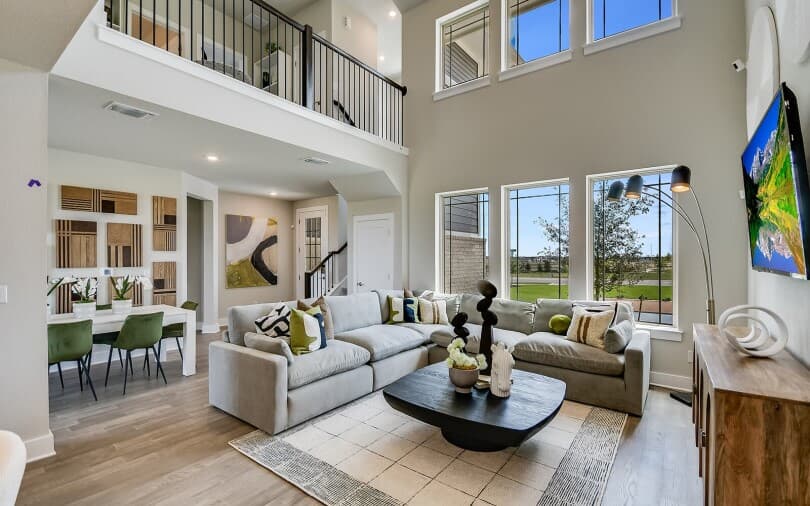
Columbia Floor Plan, Urban Courtyard Homes Collection, Easton Park Community, Austin, Texas
While the down payment is a key part of purchasing a home, it’s not the only financial factor to consider. Other elements—such as your credit score and debt-to-income ratio—can all affect how much money you’ll need to put down and what loan options are available to you.
Debt-to-Income (DTI) Ratio and Its Impact
Understanding your debt-to-income (DTI) ratio is an important part of your overall financial health. This simple (yet powerful!) number shows how much income you bring in versus how much money you spend on monthly debt payments.
So, what does this number mean for your home purchase? Lenders use your DTI ratio to help determine the risk associated with you taking on another debt payment and the likelihood you’ll be able to pay off a new loan, given your other debt obligations.
A lower DTI ratio suggests you have a healthy balance between the money coming in and the money going out. A higher DTI ratio indicates that too much of your income is going towards paying down your debts, and this raises a red flag to a lender that you may be a risky borrower.
If your DTI ratio is too high, you may be ineligible for better home loan offers like lower down payment minimums or lower interest rates.
Credit Score Requirements
Your credit score directly impacts your mortgage eligibility and loan terms, including the minimum down payment required. Lenders use your credit score as a key factor in determining your creditworthiness and assessing the risk of lending to you.
A higher credit score generally increases your chance of mortgage approval and can sometimes mean a lower down payment. A lower credit score may require you to put more money down, submit extra documentation, or even result in outright denial of your mortgage application.

Residence 3 Floor Plan, Copperleaf Neighborhood, Napa RiverSound Community, Napa, California
Mortgage Insurance
If you’re in the United States and your down payment is less than 20%, you may need to factor in private mortgage insurance (PMI). Understanding how PMI works—and how your down payment amount affects it—can help you better plan your home purchase.
PMI is insurance lenders require from homebuyers who make a down payment of less than 20% on their home purchase. It protects the lender in case the borrower defaults on the loan. PMI adds an extra cost to the borrower’s monthly mortgage payment until they reach enough equity in their home to have it removed.
The PMI cost depends on several factors, including what you can contribute towards your down payment. Generally, the more money you can put down for the home, the less you’ll pay for PMI.
If you’re buying a home in Canada with less than a 20% down payment, you’ll have to pay for mortgage default insurance. It’s similar to PMI in that mortgage default insurance protects the lender if the borrower can’t make their mortgage payments. Mortgage default insurance differs from PMI as the cost is added to the mortgage, paid over time, and cannot be removed; it stays for the life of the loan.
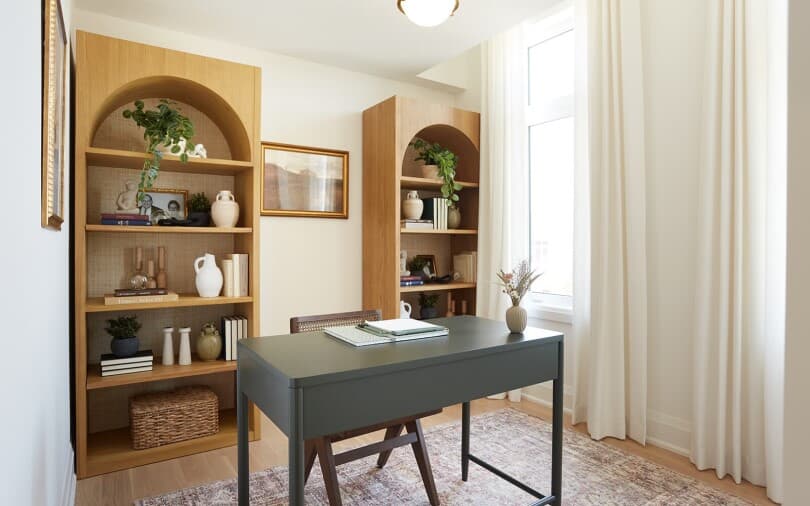
Denmar Floor Plan, Traditional Collection, New Seaton Community, Pickering, Ontario
It’s easy to focus on saving for the down payment, but that’s just one piece of the financial puzzle. To be fully prepared for closing day, you’ll also need to budget for your total upfront costs, which include the earnest money deposit, cash to close, and any additional deposits the builder requires for design upgrades or customizations.
Earnest Money Deposit
Before you make your full down payment, you’ll likely need to provide an earnest money deposit. This initial payment shows the builder you’re serious about the home purchase and committed to completing the transaction.
The earnest money deposit is typically between 1% and 5% of the home sales price but can vary based on the builder. It’s not an extra fee; it can be applied toward your down payment amount at closing. For example, if your down payment is $40,000 and you’ve already paid $10,000 as an EMD, you’ll only need to bring the remaining $30,000 at closing.
It’s important to note that there may be some scenarios where you can lose your earnest money deposit, but if the sale proceeds as expected, it will be fully applied to your down payment or other closing costs.
Cash to Close: Understanding Your Full Cost
While the down payment is a major part of your upfront costs, it’s not the only expense you need to plan for. When closing day arrives, you’ll need to bring additional funds to cover closing costs, prepaid expenses, and reserves—collectively known as your “cash to close.”
One of the essential components of your cash to close is your remaining down payment. If you made an earnest money deposit when you signed the purchase agreement, you’ll be required to pay the remaining down payment at closing.
Saving for a down payment is a huge milestone—but if that’s all you’ve planned for, you could be in for a financial shock when closing day arrives. Some buyers make the mistake of stretching their savings to hit their ideal down payment percentage, only to realize they don’t have enough left for everything else.
It’s important to plan beyond just the down payment—there are other upfront costs to consider, too. Instead of using all your savings at once, aim to set a total savings goal that covers everything you’ll need to comfortably reach the closing table.
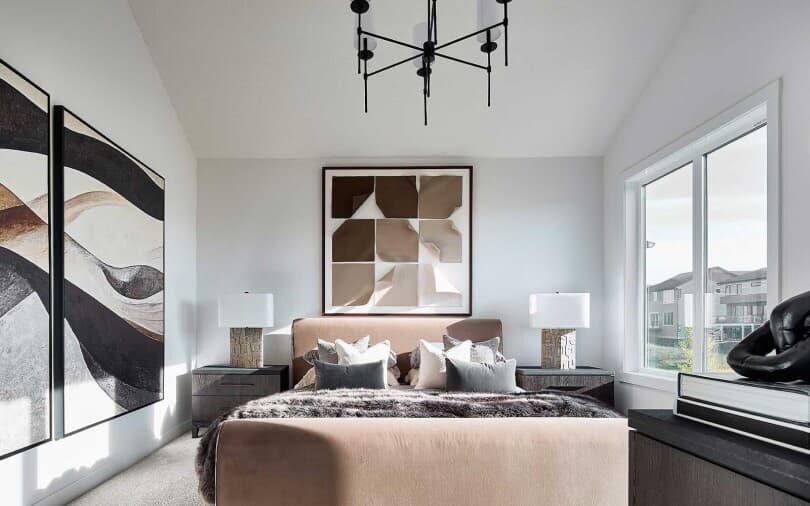
Matera 36 Floor Plan, Estate Collection, Livingston Community, Calgary, Alberta
The best approach? Save more than you think you’ll need. A well-planned budget can help you secure your dream home, move in comfortably, and have financial peace of mind.
Saving Strategies for a Down Payment
Seeing the amount you need for a down payment, closing costs, and moving expenses can feel daunting. Planning ahead and exploring financial assistance options can make homeownership more attainable.
Smart saving strategies are key to helping you build a strong financial foundation to fulfill your dream of homeownership.
- Set a clear savings goal and start now.
- Review your spending habits and create a budget.
- Improve your financial literacy and educate yourself on all the financial aspects of buying a home.
- Monitor your savings progress and make adjustments as needed.
- Stay informed about housing market conditions.
Down Payment Assistance Programs
Saving for a down payment takes time—it’s a marathon, not a sprint! If it feels like it will take forever to hit your savings goal, look into down payment assistance. These programs help bridge the gap between what you have saved and what you need for your down payment to make homeownership a reality.
Every down payment assistance program will have its own conditions, so you’ll want to do your research to see if there are income limits, credit score requirements, or any property limitations. Understanding the terms and conditions of each program is key, so seek assistance from trusted and knowledgeable professionals if you have any questions.
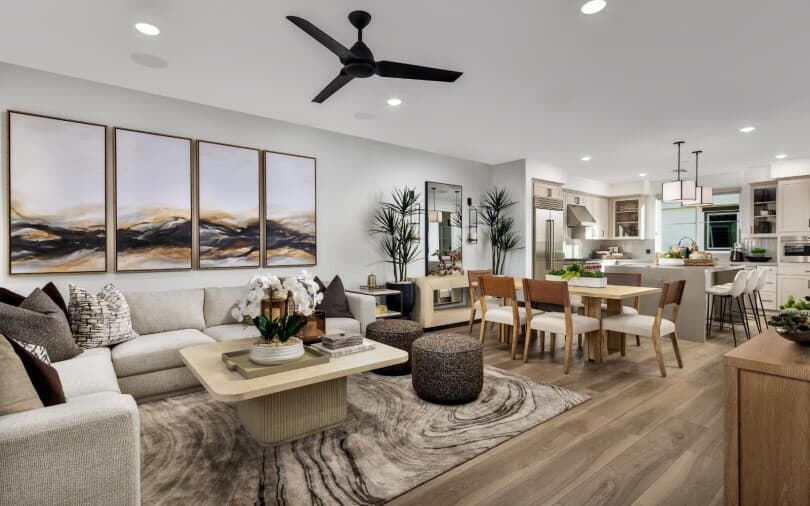
Residence 6 Floor Plan, Townhomes Collection, Magnolia Community, Arcadia, California
Special Considerations for New Construction Down Payments
When buying a new construction home, the financial process can look a little different than it does for a resale home. Builders may have unique deposit structures, payment schedules, and incentives that impact how and when you make your down payment.
For example, you may be required to pay a larger initial deposit separate from the earnest money deposit to secure your homesite. If you make any design upgrades or choose alternate structural options, additional deposits may be due at different stages of construction.
It’s important to note that any additional deposits collected by the builder are still applied to your overall down payment amount.
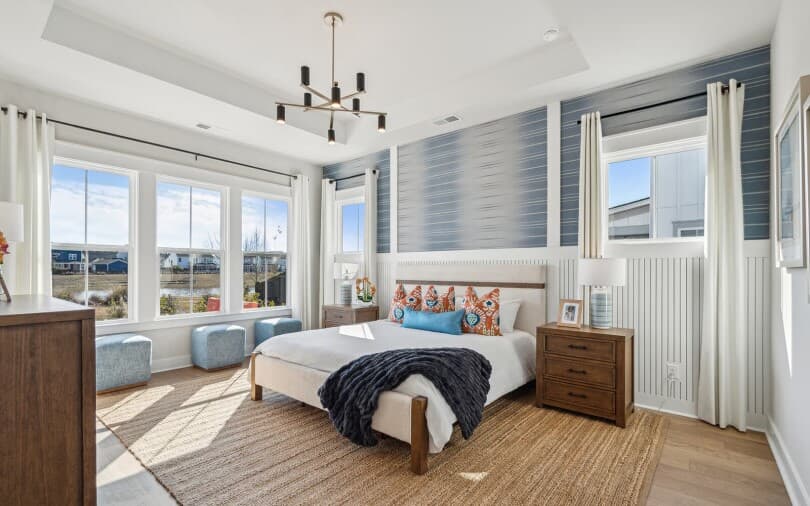
Towson Floor Plan, Single Family Homes Collection, Nexton Community, Summerville, South Carolina
A down payment is just one piece of the financial puzzle when buying a new construction home. By budgeting for all upfront costs—like deposits, closing fees, and potential upgrades—you can avoid surprises and move forward with confidence to ensure a smooth path to homeownership, from contract to closing day.
Find the Best Place to Call Home
We’re proud to help our homebuyers feel comfortable, informed, and in good hands from the first time we connect to long after they’ve moved into their new home. Our team is continuously committed to doing the right thing, cultivating an exceptional customer experience, and creating the best places to call home.
So why wait? Start your journey to homeownership today with Brookfield Residential! Explore where we build and connect with our sales team when you’re ready to learn more. We’ll be expecting you!
The information provided in this blog post is for informational purposes only and should not be considered investment, professional, or legal advice. Please consult a professional before making real estate decisions. Brookfield Residential is not responsible for any actions taken based on the information provided.
